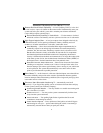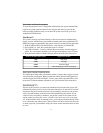
TO ACTIVATE
THE PANIC
FEATURE . . . . . . . . . .
Press button 1 for 3 seconds. The parking lights will flash
repeatedly and the siren will blare for 30 seconds or until you
press button 1 again to turn it off. If the ignition is on (indicating
you are in the car), the doors will automatically lock to
prevent an assailant from entering. If the ignition is off, the
doors will unlock, allowing you to enter immediately without
fumbling with your keys.
Anti-CodeGrabbing™ (ACG) with Random Code Encryption
A Clifford exclusive that protects you and your automobile from the most effective
and onerous car stealing device ever used by car thieves — a code-grabber.
Code-grabbers are far more effective and efficient than scanning. Unlike scanners
that sequentially transmit one digital code after another until they hit the correct
code to disarm the alarm (a process that may take minutes to years depending on the
system’s total number of codes), code-grabbers literally record, from hundreds of
feet away, the code sent by your car alarm remote control. Then the thief simply
plays back the code when you’re gone, instantly disarming the alarm and unlocking
the doors. It’s like giving the thief your car keys. Non-Clifford alarms can be
defeated that easily. In contrast, Clifford systems use complex digital signal
processing and unbreachable encryption to randomly change the digital code every
time you use the remote control. Your remote will never transmit the same code
twice, and the control unit will never accept the same code twice. Thus the code
recorded and played back by the thief’s code-grabber will never be accepted by your
Sabre II. Only ACG can make a car alarm impervious to code-grabbing, and only
Clifford systems have ACG with Random Code Encryption.
How to interpret the chirps and parking light flashes
When you use the remote control, the system responds with chirps (unless the chirp
muting feature is turned on) and parking light flashes. These chirp/flash
acknowledgments mean:
Chirps and flashes Meaning
1
Your system is disarmed or you have remotely exited valet mode (see page 10)
2
Your system is armed or you have remotely engaged valet mode (see page 10)
2 and then 4
Armed but there is a door open or the sensor is malfunctioning
(see Smart AutoTesting on page 10)
3
Disarmed but there was an intrusion attempt while you were away
(see Smart prior intrusion attempt on page 11)
4
Armed but the hood or trunk is ajar (see Smart AutoTesting on page 10)
6


















